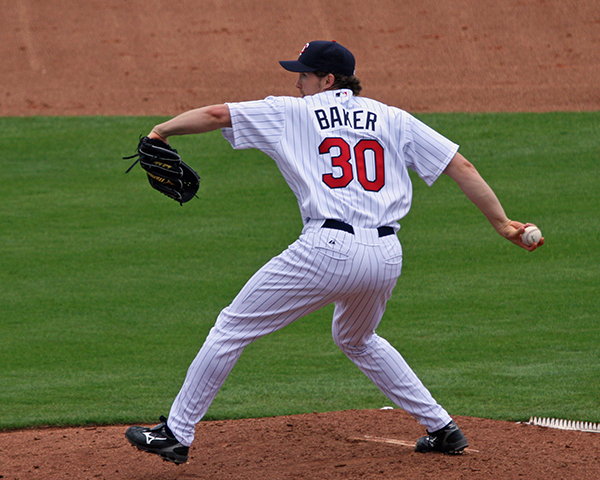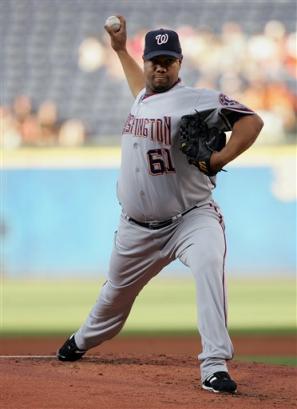Game #1: Livan
Twins 3, Angels 2 (Box Score)
 Monday night was Livan Hernandez's 8th opening day start since his career began in 1996. Officially, he is now 4-3 in those starts with one no-decision. He subdued the Angels offensive just enough to allow for the Twins' bats to find a way to score Carlos Gomez. His 7 innings, 7 hits, 2 earned runs and 1 strike out was good enough for a game score of 56, his fourth best opening day performance.
Monday night was Livan Hernandez's 8th opening day start since his career began in 1996. Officially, he is now 4-3 in those starts with one no-decision. He subdued the Angels offensive just enough to allow for the Twins' bats to find a way to score Carlos Gomez. His 7 innings, 7 hits, 2 earned runs and 1 strike out was good enough for a game score of 56, his fourth best opening day performance.
In 1998 Hernandez was tapped to pitch the opener for the Florida Marlins against the Chicago Cubs. Matching up against Hernandez was former Twins Kevin Tapani. Livan threw 5.1 innings, giving up 5 earned runs with 2 strike outs and a walk which amounted to a game score of 32. Fortunately for Hernandez and the Marlins, Tapani threw even worse: the righty couldn't get an out in the 3rd innings and finished with 9 earned runs and a game score of 6. Needless to say, Hernandez was the recipient of offense and luck.
From 2000 to 2002, Hernandez was the opening day starter for the San Francisco Giants. In 2000, Hernandez lost to the Florida Marlins but he pitched marginally well. In 6 innings, Hernandez gave up 9 hits, 3 earned runs, a walk and 5 strike outs for a game score of 42. His Marlin counterpart, Alex Fernandez, nearly duplicated his stats by throwing 7 innings with 8 hits, 3 earned runs, a walk and 5 strike outs (a game score of 55). He was spurned from a no-decision when in the 5th inning both Rich Aurilia and Barry Bonds committed a error a piece scoring future Twin Mike Redmond and Alex Gonzalez, two unearned runs that ultimately made the difference.
The Giants opened up against state rival San Diego Padres and once again had Hernandez as the inaugural pitcher in the 2001 season. Hernandez held the Padres to just 2 earned runs in 7.1 innings with 3 walks and 6 strikeouts for the victory (a game score of 61). His game score could had been substantially better had Alan Embree, who was brought in to face Tony Gwynn with Mark Kotsay on second and Phil Nevin on first, not surrendered a single to the future Hall of Famer that allowed Kotsay to score from second.
The following season the Giants faced the other in-state rival, the Los Angeles Dodgers, where Hernandez was matched-up against Kevin Brown (of the $100 million dollar bust club). Hernandez, for his part, held the Dodgers to 2 runs over 8 innings while striking out 3 and walking 3 for a game score of 66. Brown, meanwhile, only finished 4 innings and surrendered 7 runs including a home run to Barry Bonds.
From 2004 to 2006, Hernandez was the opening day starter for the Montreal Expos/Washington Nationals. In his first opening day appearance for the Les Boys in 2004, Hernandez battled phenom Josh Beckett and the Florida Marlins. For the most part, Hernandez traded innings with Beckett compiling very similar lines. Hernandez went 6 innings, giving up 5 hits, 2 earned runs, 1 walk and struck out 8 for a game score of 61. Beckett, meanwhile, went 7 innings, gave up 4 hits, 1 run and walked 3 while striking out 9, bettering Hernandez's game score with 71. Hop See Choi, the Marlin first baseman, hit a home run in the 2nd inning off of Livan to account for the difference. Though Hernandez was not factored in to the decision, the Expos still lost.
In 2005, relocated to the Nation's capital, Hernandez had the worst opening day start of his career, this time against NL East powerhouse Philadelphia Phillies. Normally an innings-eater, Hernandez did not reach the 5th and gave up 8 hits, 7 earned runs, 2 walks with 4 strike outs and a home run. This amounted to a punitive game score of 22 and Livan was credited for the loss.
His most recent opening day prior to Monday, Hernandez faced Tom Glavine and the New York Mets. While Hernandez was slightly below average (game score of 42), he did not pitch terribly and kept his team in the game by going 6 innings, scattering 8 hits while being tagged for 3 runs (one David Wright home run) with 4 strike outs and one walk. Nevertheless, Hernandez was the loser in the contest.
What this means is that this small microcosm of opening day starts paints the bigger picture for Hernandez on the whole as a pitcher. In those starts, he has accumulated a winning percentage of .571, better than his overall career winning percentage of .511. Over the course of his 8 opening day starts, Hernandez averaged 5.4 innings, his career average of 6.7 innings per game is obviously better, but he had the propensity to give up more runs in his first start (a 4.73 era opening day versus 4.25 era in his career). When you look at his game score in those starts - the best being 66, the worst being 22 - you will find that through out the season Hernandez will be right in that range. In half of his opening day starts, Hernandez pitched well enough to earn a victory by finishing with a game score over 50. In three of them, he was the winning pitcher with one no-decision. In the other half of his opening day starts, he was below 50, making it increasingly difficult for his team to keep offensive pace. He was fortunate enough to survive one of those games with a win despite a game score of 32. This means that Hernandez needs a good amount of offensive support to propel himself to an above .500 record.
It is no secret that I believe, statistically supported in this theory mind you, that Livan Hernandez will give up a considerable amount of runs for the Twins. Because his velocity is hardly of a major league caliber, he is reliant on both location and speed variations to guide him through his 6-plus innings. In some cases he's pitched well enough to not lose the ball game - often with game scores in the 50s - but others he has detonated the game by tossing games well below 40. Oddly enough, one of the most Homersota columnists in the state, Sid Hartman, also agree that the opener will also be an anomaly from Hernandez rather than the norm saying "You can't expect the kind of pitching every game that Livan Hernandez provided in giving up two runs in seven innings Monday night in a 3-2 victory over the Angels."













